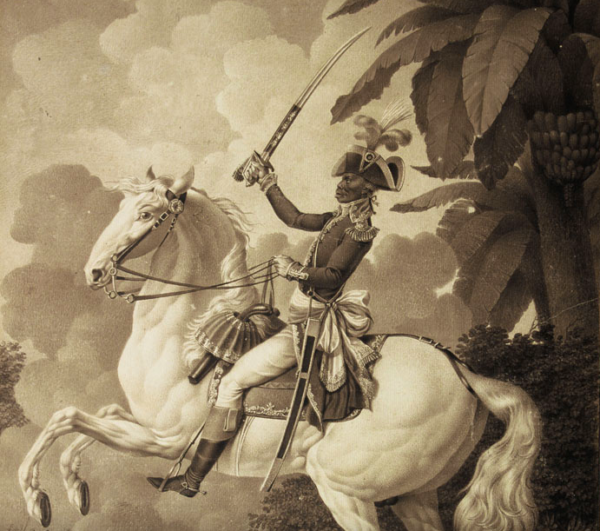Finding Toussaint Louverture, Spartacus of the Haitian Revolution

“Toussaint did not make the revolution. It was the revolution that made Toussaint. And even that is not the whole truth.”
—C. L. R. James
The iconic portrait on the cover of Sudhir Hazareesingh’s Black Spartacus: The Epic Life of Toussaint Louverture captures the dignity of the man best known as the brains behind the Haitian Revolution (1791–1804). He lived up to his last name, chosen at age fifty, which means “opening” in French, as the leader of an army of slaves, as governor of France’s richest colony, and as Commander-in-Chief of the French republican army in Saint-Domingue (now Haiti). Yet for all his genius, passion, and success, he ultimately arrived at an outcome he never wanted: an independent “Ayiti” (land of mountains”) as the first black republic in the world with France as its eternal adversary. The lessons of Toussaint’s life encompass the art of war and the power of imagination, but also deliver a crash course in the unpredictability of history.
Toussaint Bréda, named for the sugar plantation near Cap Haitian where he was born into slavery in 1743, quickly became known as “Centaur of the Savannah” for his feats of horsemanship. These included taming wild horses, riding bareback, and even making his way “across a heavily swollen river by standing fully upright on his horse and guiding the steed to the opposite bank” as a teen-ager, an image that prefigures his equestrian portrait as a military genius. As a clever young person, Toussaint distinguished himself from an early age as gardien de bêtes (animal keeper) and, eventually, as a trusted coachman for the white, French manager of the Bréda plantation. That role allowed him to overhear conversations in and around the bustling city of Cap Haitian, where he built networks of other coachmen and freed slaves. His reliability was a strategic asset in the mid-eighteenth-century, when Saint-Domingue’s African-born slaves constituted a powerful majority—500,000 slaves vs. 40,000 planters.
While largely “unthinkable,” as Haitian anthropologist Michel-Rolph Trouillot famously described it, a slave revolt was a terrifying prospect to the white, land-owning minority. If some planters imagined rebellion could be quieted with less brutal practices and a few human rights, things changed dramatically in 1789. France’s own revolution burst into the streets of Paris with a violent rejection of the monarchy and a list of ideals codified in the Declaration of the Rights of Man. Abolition of slavery became a popular “talking point” in those days as middle-class Whites (bourgeoisie) clambered for “Liberty, Equality, Brotherhood” (Liberté, Égalité, Fraternité). Such rights would not, ultimately, extend to people of color, even if France temporarily abolished slavery in its colonies through a Decree of its governing body, the National Convention, in 1794. Nevertheless, no one—including Toussaint Louverture—imagined an independent black republic before 1791, when the first major slave uprising occurred in Saint-Domingue.
His eighteenth-century blindness, for lack of a better word, can be attributed to the force of his self-esteem—which encompassed no small measure of idealism. Though not emancipated until age thirty-five, Toussaint reflected late in life that he had always been inwardly free: “I was born a slave, but nature gave me the soul of a free man.” With that attitude, he built his own army of 15,000 runaway slaves called marrons, even as he professed his continued loyalty to France. Meanwhile, he maintained a deliberately elusive presence. “He was a very private man who confided in no one,” Hazareesingh writes, “and went out of his way to conceal important information about himself, his movements, and his ultimate goals.” He also used pseudonyms to cover his tracks and understood racial tension from many perspectives. In brief, he was the perfect instigator of radical change.
“The ambition of this biography is to cut through these thickets and find our way back to Toussaint,” Hazareesingh writes. “… to return as far as possible to the primary sources, to try to see the world through his eyes, and to recapture the boldness of his thinking and the individuality of his voice.” An Oxford historian, Hazareesingh applied a similar process to previous works, including The Legend of Napoleon and In the Shadow of the General: Modern France and the Myth of DeGaulle, delving deeply into these heroic figures and de-mythologizing them. Like Napoleon and DeGaulle, Toussaint Louverture was destined to change the world. His “slave turned savior” trajectory has been deployed to glorify a nation—and a race—assumed to be incapable of accumulating power through intellect and strategy. Nor were enslaved Black people supposed to have ideals worth fighting for, never mind the discipline to fight for those ideals. In the complex tapestry of the multi-faceted, multi-national, multi-racial process we refer to as the Haitian Revolution, Toussaint Louverture provides a hero of Black liberation for all seasons. Meanwhile, he resists comparison with white heroes because his moral authority was inspired, quite simply, by a well-founded mistrust in theirs.
Hazareesingh, and every other scholar who has written about Toussaint Louverture, is aware of how easy it is to paint Toussaint Louverture as a heroic figure. In one of the most memorable formulations, Caribbean scholar David Nicholls spoke of him as “the black legend of a Haitian past,” a kind of shared ancestor whose life bestows nobility and compassion on every Haitian born since independence was declared on January 1, 1804. The psychological and conceptual value of such a sharable ancestor is understandable. Not just because of the centuries of racial injustice—all races, nations, and cultures have their heroes. In the case of Toussaint, we now have two centuries of biographers, historians, poets, playwrights, filmmakers, novelists, artists, and postage stamp designers who have devoted their talents in tribute to the life of Toussaint Louverture. Yet, this accumulation of honé, respé (honor, respect) raises a question in our own era of racial justice movements and cults of celebrity: isn’t it well past time that people in positions of authority stop being awestruck at a Black person’s significance?
In this context, Hazareesingh’s description of Toussaint Louverture as the “first black superhero of the modern age” could appear tiresome, were it not his point of departure in an effort to balance genuine heroics with human reality. Among the achievements of Black Spartacus is the author’s astonishing capacity to contextualize Toussaint Louverture as a figure of modern culture, and especially Black culture, through a detailed tracing of his exploits, wounds, emotions, uncertainties, and risk-averse attitude toward life. His propensity for striking the enemy in a thunderstorm is one of my favorite takeaways. More importantly, perhaps, the author explores Toussaint’s lasting influence on political struggles in the Caribbean and the U.S. in ways that render him relevant beyond the Haitian Revolution. Linking a humanized historic figure to current-day life is, after all, one of the uses of biography as an interdisciplinary genre. Within that frame, Hazareesingh provides a vision of the hybrid society of Saint-Domingue that has little to do with the version of eighteenth-century Enlightenment many of us learned in a college course title “Western Civilization,” with its emphasis on the glorified agency, intellect, and individuality of white, male Europeans. In other words, the author calls on the reader to envision different kinds of social organizations and power relations in a diverse, interwoven community.
Critically, Saint-Domingue did not operate on a European frequency. Rather, it was a unique society adapted to the tropical climate, social conditions, numerous languages, diverse cultures, expansive origins, forms of worship, and geography that encompassed the liminal space of the Black Atlantic. Hazareesingh guides us into the world in which Toussaint Louverture developed his radical ideas for a harmonious multi-racial, multi-national society in Saint-Domingue. In his imagination, the colony could, and should, remain part of France. As Hazareesingh explains, France’s richest colony was a place that “shaped, a lively and fertile milieu in which ideas and practices were exchanged between Europe and the Caribbean, as well as between Africa and the Caribbean, where universal concepts such as freedom, justice, and brotherhood were given specific meanings.” Toussaint evolved in that environment, at first as a matter of survival and later as a “Master of the Crossroads,” a descriptor for the Vodou spirit of Papa Legba who stands at the center with a clear view in all directions.
Hazareesingh wants his readers to understand that the Haitian Revolution was never a simple “us vs. them” conflict. Rather, it was a complex matrix of conflicts—moral and military, spiritual and earthbound—occurring in a place of immense economic and strategic value. To that end, Hazareesingh draws on an astonishing array of archival material that he helps readers negotiate with a Chronology, Glossary, maps, and more than fifty pages of Notes and Index. Among the most interesting documents is the memoir written by Toussaint Louverture’s son Isaac, published in France in 1825. Isaac addresses his family’s African ancestry in current-day Benin, his parents’ daily lives, and his father’s thinking. We also have the first-person narrative of the final phase of Toussaint’s military life in the desperate report he dictated as a prisoner at Fort de Joux during his first month of imprisonment in 1802. These seventy pages, known as Toussaint Louverture’s Mémoir, were delivered to Napoleon by his aide-de-camp General Caffarelli and published along with Caffarelli’s journal in 1853. Hazareesingh describes this vital source as an “edifying tale of the struggle between republican virtue and corruption or, as [Toussaint Louverture] put it in one of his favorites metaphors, between ‘light’ and ‘dark.’” (Note that “republican” in this context means pro-democracy). In the wake of these first-hand accounts, several biographies of Toussaint were written and published in Paris throughout the nineteenth century, including one by the famous French abolitionist Victor Schoelcher.
Only in the twentieth century did biographies by Caribbean authors appear, including the three-volume Histoire de Toussaint Louverture (1920–33) by Haitian historian H. Pauléus Sannon and the Haitian Studies classic Black Jacobins: Toussaint L’Ouverture and the Santo Domingo Revolution (1938) by C.L.R. James of Trinidad. These biographies emerged during the U.S. Occupation of Haiti (1915–1934), when issues of race, class, and foreign intervention revived post-revolutionary political divisions between those with visible links to African blood (bossales) and lighter-skinned Haitians of European ancestry (créole). The African roots of Haitian culture (indigenism) became a cause célèbre to the extent that by mid-century, François “Papa Doc” Duvalier’s felt free to glorify “authentic” Haitians of pure, African descent under the banner of noirisme. The concept of Black superiority further politicized racial politics in Haiti. Meanwhile, Toussaint Louverture’s belief in interracial brotherhood was often lost in favor of other aspects of his radical persona. As a hero for all seasons, his contradictions have allowed him to remain ever-present in Haitian social consciousness, fitting whatever container was required, much like the American founding fathers.
One of Toussaint’s most enduring contradictions relates to the drafting, signing, and presentation of his Constitution at a lavish ceremony in the center of Cape Haitian July 7, 1801, nearly three years before Haitian independence. “It was a characteristically imaginative ploy and caught everyone off guard,” Hazareesingh writes. He concedes that it was, nevertheless, an appropriate moment—socially and politically—to lay out legal principles “matured by the lessons of experience and the knowledge of localities.” Strategically, Toussaint wanted to establish a legal framework in the colony before France beat him to it by sending a culturally-illiterate white, French governor—should Toussaint become unable to serve. He felt a pressure to conserve hard-won gains once Napoleon emerged as the leader of France in November 1799 and promptly canceled the right of colonial representatives to participate in France’s National Assembly. There was also anxiety that the 1794 abolition of slavery throughout French colonies might be reversed with the stroke of a pen, which indeed it was, in May 1802 in the Lower Anitlles. Finally, Napoleon made his policy toward Saint-Domingue clear when he invaded the island with an expeditionary force of 20,000 French soldiers in January 1802. His brother-in-law, General Leclec, was instructed to capture and deport Toussaint and his family to France, which he did, though only Toussaint was transported to Fort de Joux and imprisoned.
These dramatic events rendered Toussaint’s Constitution irrelevant, although his defense of it in his Mémoir has been debated by historians. Hazareesingh describes it as a “quasi-declaration of independence.” It was also an authoritarian power grab in which Toussaint appointed himself “governor for life” with the right to choose his successor through a secretive process. As for putting an end to slavery, plantation laborers (cultivateurs) would now be compensated, but were denied freedom of movement outside the confines of the plantations on which they found themselves in 1801. Toussaint believed this would spark agricultural production—including on the four coffee plantations he owned—but this was not the freedom enslaved people had fought for.
Inevitably, these “two very contentious areas” remain a stain on the reputation of Toussaint Louverture. Like many, Hazareesingh takes the view that Toussaint’s 1801 Constitution was a significant step toward Haiti’s nationhood because the document made it clear that “the colony’s freedom was no longer dependent on French political thinking or practice.” Crucially, it dared to assert the inviolable end to slavery in Saint-Domingue when it stated that “There can be no slaves on this territory, servitude has been forever abolished.” Yet in the spirit of “famous last words,” Toussaint’s Constitution also stated that “There, all men are born free, live and die free and French.”
Linking past and present through the filter of Toussaint Louverture’s life, Hazareesingh connects the controversy surrounding the 1801 Constitution to the “long tradition of post-independence institutional absolutism” in Haiti, an attitude that resonates with Toussaint’s paternalistic authority. This observation presages Haiti’s series of charismatic, overbearing personalities whose tenures have often led to corruption, mistrust, or worse. Would we have a different Haiti today if its first charismatic leader had been less provocative, less authoritative, less bold? Or would there be no Haiti at all? What version of Toussaint might have worked better than the one who provoked a French invasion while professing loyalty to France with deference to Napoleon? “I rely entirely on your justice and impartiality,” he wrote in his Mémoir.
In any case, it seems that Toussaint’s over-reach set a series of events in motion, including General Jean-Jacques Dessalines’s determination to sever the colony from France. “Cut off their heads, burn down their houses!” he said, with reference to French planters. As that order was being carried out, Toussaint was dying of pneumonia in his prison cell. He succumbed on April 7, 1803. A few months later, Napoleon banned Black and mixed-race people from entering France.
Security was clearly the point when the medieval Château de Joux, built on an outcropping of jagged rock, was redesigned and fortified in the seventeenth century as a fairy tale castle gone berserk. What better place for Toussaint Louverture’s memory to linger, like a ghost, in the maze of tunnels, towers, small rooms, deep wells, and vast terraces where French soldiers once gathered for roll call? My own persistent memory from this ominous touchstone of Haitian history is not its grandeur (it was designed by Louis XIV’s chief engineer, Vauban) but the single window in Toussaint’s cell. No one could ever hope to escape this isolated place, yet it was still barred with iron and filled with bricks. Only one slice of light cut across the top.
Anyone who has experienced Haiti’s intense sunlight can imagine the cruelty of that thin bright blade that threw the rest of the room into musty obscurity. I imagined the presence of the famous prisoner there, sixty years old, coughing in the shadows as he dictated his Mémoir, hoping that the First Consul would read it and agree to talk. He waited in silence, especially after his manservant was dismissed and his pen and paper were taken from him in November. As winter set, his firewood was rationed. His cough worsened. Perhaps he braced himself for sleepless nights with frequent, full-body searches at all hours. Or perhaps he didn’t care. I found little to commemorate him in that lonely place. There is only a bronze plaque added by a Haitian delegation in 2003 that reads: “To the Honor and Glory of Toussaint Louverture.”
Haitian independence was declared on January 1, 1804 by General Jean-Jacques Dessalines an event that, Hazareesingh explains, is “sometimes portrayed” as Toussaint’s second death because it represents a failure of his grand vision for Saint-Domingue. “He did not want to break free from France, and until the very end held onto the belief that the French would realize that their objectives could not be achieved by military force, and that a mutually beneficial arrangement with Saint-Domingue’s revolutionary leaders could be reached.” Though “not entirely unrealistic” in his biographer’s estimation, there is clearly no de-mythologizing Toussaint Louverture without the soft erasure of his original vision for Saint-Domingue. As for the glory of “the first black republic in the world,” Hazareesingh acknowledges that “The regime which emerged after independence, which explicitly rejected the colony’s European heritage, appeared to be the antithesis of Toussaint’s dream of a multiracial democracy.” In the end, he had fought hard for a vision, an ideal that could not be realized, or even understood by, by his cynical successor.
For those who truly wish to “get back to Toussaint Louverture,” the challenge is to pause before the glorious end of the Haitian Revolution and contemplate his unfulfilled promise alongside his immense accomplishments. He was a legendary hero of Black liberation—but what about the harmonious, multi-racial democracy he imagined in which liberty, equality, and brotherhood mattered more than contested territory? Those goals could not be met in the context of the Haitian Revolution, in part because of the justifiable fury, conflict, and violence that slavery created. And yet, he was also a figure of hope whose arguments for multiracial brotherhood remain compelling, even necessary, as they speak to us through time in the final lines of his Mémoir: “Did my color prevent me from serving my country with zeal and loyalty? Does the color of my skin get in the way of my honor and bravery?” Toussaint’s best argument was himself, and his hope for justice lingers thanks in part to this remarkable biography.
About Patti Marxsen
Patti M. Marxsen is the author of Jacques Roumain : A Life of Resistance (Caribbean Studies Press), which shared the 2019 Book Prize of the Haitian Studies Association.





